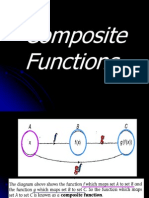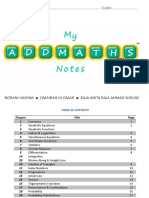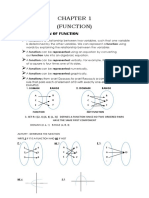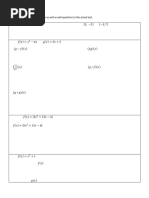Answers - Exercise 1 Functions
Uploaded by
Michael MyamboAnswers - Exercise 1 Functions
Uploaded by
Michael MyamboTROCKERS ONLINE REVISION
Upper 6th TERM 3 2020
Wednesday 04 November 2020
EXERCISE 1: FUNCTIONS
Answers-20 Marks
1. Functions 𝑓 and 𝑔 are defined by
𝑓(𝑥) = 2(𝑥 − 1)2 + 3, 𝑥 ∈ ℝ
𝑥−3
𝑔(𝑥) = √ + 1, 𝑥 ∈ ℝ: 𝑥 ≥ 𝑝
2
(i) State the value of 𝑝. [1]
𝑝=3
𝑥−3
𝑁𝐵: ≥0
2
𝑥−3≥0
𝑥≥3
(ii) Find 𝑓𝑔(𝑥) and sketch the graph of 𝑓𝑔(𝑥) for 0 ≤ 𝑥 ≤ 4. [5]
𝑓𝑔(𝑥) = 2[𝑔(𝑥) − 1]2 + 3
2
𝑥−3
= 2 (√ + 1 − 1) + 3
2
2
𝑥−3
= 2 (√ ) +3
2
𝑥−3
= 2( )+3
2
=𝑥−3+3
=𝑥
𝑦
𝑥
0 4
Falling down is an accident. Staying down is a choice Page 1
© Tarakino N.P. 0772978155/0717267175
(iii) Hence, deduce the relationship between
a) 𝑓(𝑥) and 𝑔(𝑥), [1]
𝑔(𝑥) = 𝑓 −1 (𝑥) or 𝑓(𝑥) = 𝑔−1 (𝑥)
𝑁𝐵: 𝑓𝑓 −1 (𝑥) = 𝑓 −1 𝑓(𝑥) = 𝑥
b) the graph of 𝑓(𝑥) and the graph of 𝑔(𝑥). [1]
They reflect along the line 𝑦 = 𝑥
(iv) Sketch the graph of 𝑔(𝑥) for 3 ≤ 𝑥 ≤ 11 and clearly state its range. [3]
𝑥−3
𝑔(𝑥) = √ +1
2
𝑦
1
𝑥
0 3 11
Range: 𝑦 ∈ ℝ: 1 ≤ 𝑦 ≤ 3
2. 𝑓(𝑥) = 2𝑥 + 1, 𝑥 ∈ ℝ .
(i) Find
a) 𝑓 2 (𝑥), where 𝑓 2 (𝑥) = 𝑓𝑓(𝑥), [1]
𝑓(𝑥) = 2𝑥 + 1
⇒ 𝑓 2 (𝑥) = 𝑓𝑓(𝑥) = 2𝑓(𝑥) + 1
= 2(2𝑥 + 1) + 1
= 4𝑥 + 2 + 1
= 4𝑥 + 3
b) 𝑓 3 (𝑥). [1]
𝑓 2 (𝑥) = 4𝑥 + 3
⇒ 𝑓 3 (𝑥) = 𝑓[𝑓 2 (𝑥)] = 2𝑓(𝑥) + 1
= 2(4𝑥 + 3) + 1
= 8𝑥 + 6 + 1
= 8𝑥 + 7
Falling down is an accident. Staying down is a choice Page 2
© Tarakino N.P. 0772978155/0717267175
(ii) Deduce the result for 𝑓 𝑛 (𝑥). [2]
𝑓(𝑥) = 2𝑥 + 1 = 21 𝑥 + (21 − 1)
𝑓 2 (𝑥) = 4𝑥 + 3 = 22 𝑥 + (22 − 1)
𝑓 3 (𝑥) = 8𝑥 + 7 = 23 𝑥 + (23 − 1)
⇒ 𝑓 𝑛 (𝑥) = 2𝑛 𝑥 + (2𝑛 − 1)
(iii) Hence, prove by mathematical induction the result in 2(ii). [5]
𝑓 𝑛 (𝑥) = 2𝑛 𝑥 + (2𝑛 − 1)
When 𝑛 = 1:
LHS
𝑓 𝑛 (𝑥) = 𝑓(𝑥) = 2𝑥 + 1
RHS
2𝑛 𝑥 + (2𝑛 − 1) = 21 𝑥 + (21 − 1)
= 2𝑥 + (2 − 1)
= 2𝑥 + 1
Since 𝐿𝐻𝑆 = 𝐿𝐻𝑆 ÷ the statement holds for 𝑛 = 1
Assuming true for 𝐧 = 𝐤:
𝑓 𝑘 (𝑥) = 2𝑘 𝑥 + (2𝑘 − 1)
Then for 𝒏 = 𝒌 + 𝟏:
𝑓 𝑘+1 (𝑥) = 2𝑘+1 𝑥 + (2𝑘+1 − 1)
Proof
𝑓 𝑘+1 (𝑥) = 2𝑘+1 𝑥 + (2𝑘+1 − 1)
LHS:
𝑓 𝑘+1 (𝑥) = 𝑓[𝑓 𝑘 (𝑥)]
= 2𝑓 𝑘 (𝑥) + 1
= 2[2𝑘 𝑥 + (2𝑘 − 1) ] + 1
= 2𝑘+1 𝑥 + (2𝑘+1 − 2) + 1
= 2𝑘+1 𝑥 + (2𝑘+1 − 1) 𝑤ℎ𝑖𝑐ℎ 𝑖𝑠 𝑡𝑟𝑢𝑒 𝑓𝑜𝑟 𝑛 = 𝑘 + 1
∴The statement holds for 𝑛 = 𝑘 + 1
Since the statement is true for 𝑛 = 1, 𝑛 = 𝑘 and 𝑛 = 𝑘 + 1 ∴ by induction the statement
holds for all 𝑛 ∈ ℤ+ .
Psalms 145:14-16 ~ Tarakino N.P. (Trockers)
Falling down is an accident. Staying down is a choice Page 3
© Tarakino N.P. 0772978155/0717267175
You might also like
- Complete Download C++ Programming: An Object-Oriented Approach, 1e ISE 1st Edition Behrouz A. Forouzan - eBook PDF PDF All Chapters100% (7)Complete Download C++ Programming: An Object-Oriented Approach, 1e ISE 1st Edition Behrouz A. Forouzan - eBook PDF PDF All Chapters59 pages
- Dr. Basant Agarwal - Hands-On Data Structures and Algorithms With Python - Store, Manipulate, and Access Data Effectively, 3rd Edition-Packt (2022)0% (1)Dr. Basant Agarwal - Hands-On Data Structures and Algorithms With Python - Store, Manipulate, and Access Data Effectively, 3rd Edition-Packt (2022)10 pages
- PDF GenMath BusinessMath Statistics-for-NAT-Review PDFNo ratings yetPDF GenMath BusinessMath Statistics-for-NAT-Review PDF243 pages
- BUSINESS MATHEMATICS - Functions and GraphsNo ratings yetBUSINESS MATHEMATICS - Functions and Graphs13 pages
- Introductory Message: Golden Gate CollegesNo ratings yetIntroductory Message: Golden Gate Colleges8 pages
- Note 1.1 Functions Exercise 1.1: F (0) - 3 and F (6)No ratings yetNote 1.1 Functions Exercise 1.1: F (0) - 3 and F (6)12 pages
- 1 Functions: P Q P:Domain Q: Codomain A B A: Domain B: CodomainNo ratings yet1 Functions: P Q P:Domain Q: Codomain A B A: Domain B: Codomain25 pages
- Lesson 3 - Functions Extension Activity SheetNo ratings yetLesson 3 - Functions Extension Activity Sheet4 pages
- Solution Manual For Calculus for Business, Economics, and the Social and Life Sciences, Brief Version 11th Edition by Laurence Hoffmann, Gerald Bradley, David Sobecki, Michael Price - Available For Instant Download And Reading100% (1)Solution Manual For Calculus for Business, Economics, and the Social and Life Sciences, Brief Version 11th Edition by Laurence Hoffmann, Gerald Bradley, David Sobecki, Michael Price - Available For Instant Download And Reading31 pages
- Lesson Week 1. Relation Functions Operations and Word ProblemsNo ratings yetLesson Week 1. Relation Functions Operations and Word Problems60 pages
- Week 4 Composition of Functions Inverse of FunctionsNo ratings yetWeek 4 Composition of Functions Inverse of Functions6 pages
- The University of Zambia School of Natural SciencesNo ratings yetThe University of Zambia School of Natural Sciences6 pages
- The College of Maasin: Module 3: Operation On FunctionsNo ratings yetThe College of Maasin: Module 3: Operation On Functions6 pages
- Exercise 4 - Answers Chaks Pure MathematicsNo ratings yetExercise 4 - Answers Chaks Pure Mathematics11 pages
- PC Solutions Unit 2 - Functions and LimitsNo ratings yetPC Solutions Unit 2 - Functions and Limits13 pages
- Functions 1.1 Functions As Mathematical ModelsNo ratings yetFunctions 1.1 Functions As Mathematical Models13 pages
- Solution Manual For Calculus For Business Economics and The Social and Life Sciences Brief Version 11th Edition by Laurence Hoffmann Gerald Bradley David Sobecki Michael Price100% (46)Solution Manual For Calculus For Business Economics and The Social and Life Sciences Brief Version 11th Edition by Laurence Hoffmann Gerald Bradley David Sobecki Michael Price5 pages
- De Moiver's Theorem (Trigonometry) Mathematics Question BankFrom EverandDe Moiver's Theorem (Trigonometry) Mathematics Question BankNo ratings yet
- Analytic Geometry: Graphic Solutions Using Matlab LanguageFrom EverandAnalytic Geometry: Graphic Solutions Using Matlab LanguageNo ratings yet
- Business Studies 91982 Paper 2 November 2017 SessionNo ratings yetBusiness Studies 91982 Paper 2 November 2017 Session8 pages
- Answers - Online Daily Test 7 - TrockersNo ratings yetAnswers - Online Daily Test 7 - Trockers7 pages
- Answers - Online Daily Test 2 - Trockers-1No ratings yetAnswers - Online Daily Test 2 - Trockers-15 pages
- Answers-Chaks Pure Maths P2 Ex 1 Pure Mathematics0001No ratings yetAnswers-Chaks Pure Maths P2 Ex 1 Pure Mathematics000113 pages
- 2020 P2 Seminar Presantation by TrockersNo ratings yet2020 P2 Seminar Presantation by Trockers46 pages
- 9707 Business Studies: MARK SCHEME For The May/June 2007 Question PaperNo ratings yet9707 Business Studies: MARK SCHEME For The May/June 2007 Question Paper7 pages
- (FREE PDF Sample) Professional C++ Gregoire Ebooks100% (16)(FREE PDF Sample) Professional C++ Gregoire Ebooks62 pages
- Lecture No 3 Predicates and Quantifiers 03102022 065335pm 20022023 061254pmNo ratings yetLecture No 3 Predicates and Quantifiers 03102022 065335pm 20022023 061254pm18 pages
- CS8392 Object Oriented Programming MCQ 4No ratings yetCS8392 Object Oriented Programming MCQ 410 pages
- Download Complete (Ebook) Hello World!: Computer Programming for Kids and Other Beginners by Warren Sande, Carter Sande ISBN 9781617290923, 1617290920 PDF for All Chapters100% (5)Download Complete (Ebook) Hello World!: Computer Programming for Kids and Other Beginners by Warren Sande, Carter Sande ISBN 9781617290923, 1617290920 PDF for All Chapters65 pages
- Chapter 4 (Processors and Memory Hierarchy)100% (1)Chapter 4 (Processors and Memory Hierarchy)17 pages
- Python Programming Top of The Stack by Darren LefcoeNo ratings yetPython Programming Top of The Stack by Darren Lefcoe314 pages
- M.Sc.(Computer Science) (for Dept.)_16012024No ratings yetM.Sc.(Computer Science) (for Dept.)_1601202421 pages
















































































































